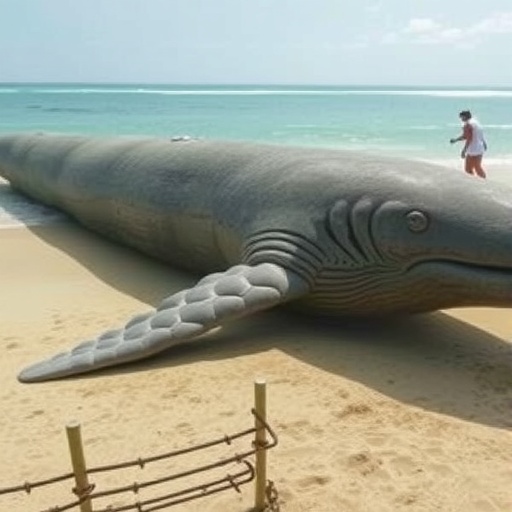In a groundbreaking revelation that reshapes our understanding of whale evolution, scientists at Museums Victoria’s Research Institute have described a new species of ancient whale, identified from a 26-million-year-old fossil unearthed near Jan Juc on Wadawurrung Country along Victoria’s renowned Surf Coast. This extraordinary find, named Janjucetus dullardi, stands apart from the gentle leviathans we witness today, revealing a fierce, toothy predator operating in the warm, shallow seas of the late Oligocene epoch. Unlike modern baleen whales, which filter feed through baleen plates, Janjucetus dullardi represents an earlier, toothed lineage that thrived during a critical period in cetacean evolutionary history.
The fossil, a remarkably preserved partial skull including ear bones and dentition, was discovered serendipitously by local resident Ross Dullard in 2019. Recognizing the immense scientific value of this specimen, Dullard generously donated it to Museums Victoria. In acknowledgment of his contribution, the species now bears his name. This contribution exemplifies how everyday encounters with our natural world can unlock biology’s deepest narratives, illustrating the critical role of citizen science and community engagement in paleontological discoveries.
Meticulously prepared and analyzed using state-of-the-art microCT scanning technology, the fossil’s exceptional preservation allows an unprecedented exploration into the morphology of early mysticetes, or baleen whales. These scans unveiled delicate internal structures within the ear bones, such as the cochlea — a critical organ linked to hearing capabilities. Such detail illuminates functional adaptations that likely aided Janjucetus dullardi in spatial hearing and underwater navigation, vital faculties for a predatory lifestyle in aquatic environments.
An intriguing aspect of this juvenile specimen is its relatively small size, approximately two meters in length, comparable to modern dolphins rather than the colossal whales familiar today. Its compact build, combined with forward-facing large eyes and sharp, slicing teeth, supports interpretations of a highly adapted predator that hunted with agility and precision. This morphology sharply contrasts with contemporary baleen whales’ vast size and filter-feeding anatomy, underlining a striking evolutionary trajectory spanning millions of years from toothed carnivores to gentle giants.
Janjucetus dullardi belongs to the mammalodontids, an enigmatic and ancient clade within the toothed mysticetes that lived exclusively in the Oligocene, roughly 30 to 23 million years ago. Until now, only three mammalodontid species had been recognized globally, with prior finds concentrated in Victoria, Australia. This discovery enriches the global fossil record and solidifies southeast Australia’s status as a paleontological hotspot crucial for understanding early whale diversification and adaptation to marine environments.
Detailed anatomical analysis reveals that mammalodontids like Janjucetus possessed a combination of primitive and derived traits, highlighting key steps in the transformation from their terrestrial ancestors to fully aquatic cetaceans. The retention of dentition suited for slicing meat contrasts with their modern baleen-bearing descendants, indicating a complex evolutionary mosaic where filter feeding evolved subsequent to toothed predation. The study of these morphological transitions provides vital clues about functional shifts in feeding mechanisms, sensory adaptations, and locomotion in early cetaceans.
Furthermore, examination of the inner ear structures elucidates sensory capabilities linked to echolocation and hearing underwater, essential for hunting and navigation. Although modern toothed whales (odontocetes) rely heavily on sophisticated echolocation, the sensory repertoire of early mysticetes like Janjucetus dullardi suggests an intermediate stage of auditory sophistication. These insights help decode the sequence in which auditory functions evolved alongside ecological niches, shedding light on how early whales interpreted and interacted with their underwater worlds.
Ecologically, this ancient whale inhabited a coastal region characterized by warmth and rising sea levels, as indicated by the Jan Juc Formation’s depositional context. Such paleoenvironmental conditions influenced evolutionary pressures, shaping niche availability and marine biodiversity. Understanding how early whales adapted to these dynamic environments millions of years ago offers contemporary parallels, helping predict responses of marine mammals to ongoing climate change and oceanic shifts in today’s warming seas.
The discovery of Janjucetus dullardi notably contributes to filling gaps in ontogeny studies—the growth and development patterns of extinct species. As a juvenile specimen, it reveals developmental stages previously undocumented in mammalodontids, opening a window onto how early whales matured and transitioned from infancy to adulthood within ancient marine ecosystems. This has profound implications for reconstructing life histories and behavior of extinct marine mammals.
From a broader evolutionary perspective, this fossil challenges simplistic narratives of whale evolution, emphasizing a complex, branching lineage rife with ecological experimentation before the eventual dominance of filter-feeding giants. It aligns with emerging evidence indicating that mysticetes evolved through diverse morphological experiments revealing myriad survival strategies. By uncovering these “plot twists,” the Janjucetus dullardi specimen fundamentally enriches our understanding of cetacean evolutionary biology.
The team of researchers, led by Dr Erich Fitzgerald and PhD student Ruairidh Duncan, underscore the significance of this discovery as part of an ongoing wave of paleontological advancement emanating from southeastern Australia. With numerous other fossils awaiting detailed study, the region promises further revelations that could continue to rewrite evolutionary textbooks. The convergence of advanced imaging technologies, dedicated fieldwork, and historical collections is heralding a renaissance in marine vertebrate paleontology.
In summary, Janjucetus dullardi embodies a remarkable fossil discovery, painting a vivid picture of early whale ecology, anatomy, and evolutionary innovation. Its sharp teeth, keen eyesight, and compact physique directly contradict modern conceptions of mysticetes as gentle filter feeders, reminding us of the dynamic and varied pathways life has traversed across deep time. As we continue to explore these ancient mysteries, each find serves as a powerful testament to evolution’s intricate artistry and enduring influence on the natural world.
Subject of Research: Animals
Article Title: An immature toothed mysticete from the Oligocene of Australia and insights into mammalodontid (Cetacea: Mysticeti) morphology, systematics, and ontogeny
News Publication Date: 13-Aug-2025
Web References: http://dx.doi.org/10.1093/zoolinnean/zlaf090
Image Credits: Artwork by Ruairidh Duncan. Source – Museums Victoria
Keywords: Evolutionary biology, Whales, Marine mammals, Paleontology




